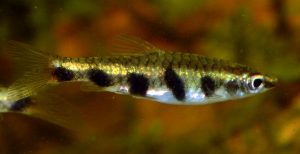The Barred Espei Pencilfish (Nannostomus espei) is also known to tropical fish keeping enthusiasts as Espei’s Pencilfish, Four-Barred Pencilfish, or Banded Pencilfish and is endemic to the Mazaruni River system in Guyana, from the Peaima to Tiboku waterfalls, including many of its tributaries such as the Kurupung, Eping, and Tabuba. There are also unconfirmed occurrences from the Casiquiare Canal and Río Ventauri, Venezuela (Río Orinoco drainage).
Nannostomus espei are easily identified by their 5 dark vertically oriented bars on the sides of each golden colored flank. Although most Nannostomus spp. display vertically barred patterns at night, the Barred Espei Pencilfish is the only one that permanently displays the barred pattern.
This pencilfish species possesses an adipose fin that many pencilfish do not. Like all pencilfish, they have a small terminal mouth that always appears to be open. Females of the species are always stockier than the males, and the golden stripe on the females is less colorful than on the males.
Barred Espei Pencilfish are found in densely vegetated small rivers, blackwater tributaries, and swampy areas typically where there is a lot of overhanging vegetation that produces substantial leaf litter, submerged logs, and woody branches. The humic acids and other chemicals released by the decaying organic material typically stains the water a coffee color and creates a pH as low as 4.0 with a negligible mineral content.
Barred Espei Pencilfish are a peaceful, gregarious, slow moving, shoaling species that do not make great candidates for a community tank. They do best in a biotope setting with at least a dozen or more of their own kind to minimize aggression and should never be kept alone in a community tank.
Although they do well with smaller callichthyids, loricriid catfish, dwarf cichlids, and non aggressive characids, their small size and timid nature often put them in danger.
In an aquarium environment they should be housed in a mature densely planted tank of at least 10 gallon capacity, with a dark sandy or fine gravel substrate, some driftwood branches, floating plants
to provide cover, and some dried Indian Almond Leaves
to provide the establishment of valuable microbe colonies. The microbe colonies created by the decaying dried leaf litter also provide a secondary food source for the fry. The decaying leaves also release tannins and other chemicals into the water that are medicinal to the fish and act as a buffer.
Because they are found in slow moving water, a corner air powered sponge filter is all the filtration needed for Barred Espei Pencilfish. They do not like a strong current in their tank.
Barred Espei Pencilfish have been bred in an aquarium environment, usually in a mature, densely planted tank with very soft, acidic water, where the fry started appearing without any human intervention. If you place a conditioned group of two males with several females together in a densely planted tank of Echinodorus, Anubias, or Microsorum with aged water, breeding will eventually take place. This species is highly selective when choosing mates but when a pair does develop, they will begin laying small clumps of eggs underneath the plant leaves.
During courtship, the male will swim above the female and nudge her on the head. Using his bag like anal fin, the male will attach anywhere from 20 to 40 eggs to the underside of the broad leaved plants. When the eggs are seen, remove the plants or the adults into a separate tank to prevent them from eating the eggs. The fry will begin to appear within 24 to 36 hours after the eggs are deposited, and they should be free swimming 5 or 6 days thereafter.
Feed the fry Paramecium or a very fine dry fry food until they are able to eat microworms, newly hatched baby brine shrimp, and daphnia.
In their natural environment, Barred Espei Pencilfish are micro predators that feed on zooplankton and minute invertebrates. In an aquarium environment, they can be fed a quality dried flake food but require daily offerings of live, frozen, or freeze dried baby brine shrimp, grindal worms, Daphnia
, etc.
Barred Espei Pencilfish (Nannostomus espei) are not common in the aquarium hobby and are relatively expensive when they do become available online or in specialty tropical fish keeping shops. When available, they are usually about 3/4″ to 1″ in size.
Minimum Tank Size: 10 gallons
Care Level: Moderate
Temperament: Peaceful
Hardiness: Moderately Hardy
Water Conditions: 72-83° F, 18 – 90 ppm, pH 4.0-6.5
Max. Size: 1.25″
Color Form: Gold, Black
Diet: Omnivore
Compatibility: Single species tank
Origin: Guyana
Family: Lebiasinidae
Lifespan: 2-5 years
Aquarist Experience Level: Beginner



